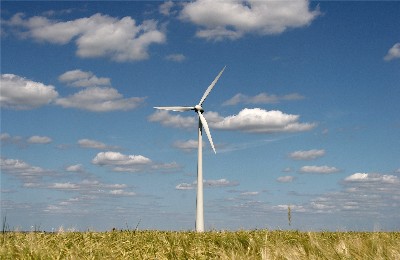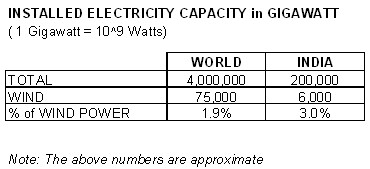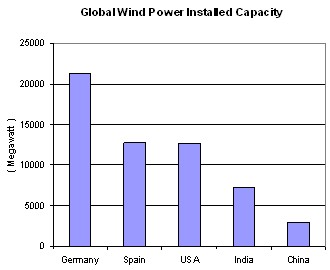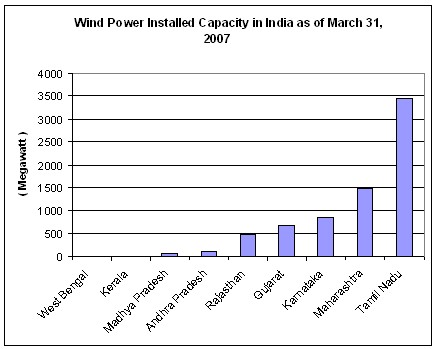Poetical context aside, the Bob Dylan’s lyric “-the answer, my friend, is blowin’ in the wind–-” can be appropriately applied to wind as an available and renewable source of much needed energy in the context of today’s environmental problems. Our civilization is vitally dependent on supply of energy that drives the machines to support an increasingly rising standard of living among nations. Whereas conventional sources of energy -coal, oil, gas and nuclear fuel- provide the bulk of energy need, the only significant renewable source of energy – hydro power- provides only about 20% of global electricity need. In the last fifty years the population of the world has increased three times, but the demand for electricity has gone up more than fifteen times. Dependence on conventional fuel to meet this staggering demand has created a dangerous environmental situation that includes the greenhouse effects. Ex-VP Al Gore has been a champion of an awakening of this grave danger that faces the human race. There is ample evidence that business as usual as far as energy supply is concerned is untenable and humanity has to find alternatives for the survival of the race.
A partial answer to the problem can be sought in the utilization of wind as a source of energy that is renewable and plentiful all across the surface of the earth. Unlike the conventional sources of energy, it does not cause toxic and greenhouse gas emissions. Wind energy is the result of uneven solar heating of the mainly tropospheric blanket of air that envelops the earth for about 10 miles. This causes air masses to move in a complex pattern. The moving mass of air by virtue of its velocity carries with it kinetic energy that can be transformed to usable electricity by wind turbines. In the olden days, before invention of electricity, the same energy was converted into mechanical energy in wind mills. The process of generating electricity by wind turbines is the reverse of a household air circulating fan that consumes electricity and rotates the blades causing air mass to move. Wind turbines are driven by the force of moving wind impinging on a set of blades and the turbine/generator turns the mechanical energy into electricity. A typical wind tower is shown in Figure 1.

(Ref: http://en.wikipedia.org/wiki/Wind_power)
Wind as a source of energy has been known to mankind for thousands of years although the knowledge to transform to electricity has been relatively recent. As early as 1700 BC, windmills were employed mechanically to water the planes of Mesopotamia. There is also written evidence of early utilization of windmills in Afghanistan and Iran.
Although wind is one of civilization’s oldest forms of energy, it suffered setback beginning last century as the benefits of cheap conventional energy supply became available. But as the true cost of conventional energy sources have become more and more evident, wind power is making a strong comeback during the last few decades. Although, installation of wind power is growing at brisk pace, its contribution to the total installed electric capacity is still very small as shown in Table 1.

Among the countries in the forefront of wind power development is India as shown in Table 2.

The state in India that has seen substantial growth in wind power generation is Tamil Nadu. A major wind farm is operational in Muppandal (Figure 2) - a small coastal town near Kanyakumari. Muppandal region has one of the largest concentrations of wind generators and generates an aggregate of 540 MW of electricity. It has presented employment opportunities for the youth and brought prosperity to an otherwise barren area.
Table 3 shows the wind power installed capacity in various Indian states. At present Assam has no installed wind power capacity.

In a recent communication with the Government of Assam, the author was told that wind power is not feasible in Assam because of damp weather. The author is yet to receive any feasibility study to support that statement. Furthermore, there are only two operational wind-monitoring stations in Assam. To dismiss wind power development in Assam without a thorough exploration is unacceptable. This mindset has to change and a vigorous attempt should be made to identify locations to install wind power generators in Assam. Assam must develop sustainable and renewable energy sources like wind, run of the river hydro, mini and micro hydro plants rather than placing short sighted emphasis on massive hydroelectric plants in the highly seismic area because of the obvious and unacceptable risk that they present to the people of Assam for now and into the future. Assam should be able to develop wind power capability in a public-private enterprise provided enough incentives are chalked out. There is no case that it is not technically feasible. John F. Kennedy set the goal to put a man on the moon- a seemingly impossible task a few decades ago that was materialized. The Chinese are contemplating controlling the weather during the 2008 Olympic Games in Beijing by firing artillery and dispersing clouds. If these can be materialized, wind power can certainly be materialized in Assam. All it needs is a resolve and a change of mindset.
- Umesh C. Tahbildar
- Log in to post comments
Comments
Would like to know more about
Would like to know more about wind energy. Kindly let me know how. BTW I am bad at maths!
Dear Dr. Tahbildar, I
Dear Dr. Tahbildar,
I wanted to share some initiatives taken by few researchers on the wind energy in the North Eastern part of India. I am wondering whether you can send me your email id.
Regards,
Karuna Kalita
karunakalita@gmail.com